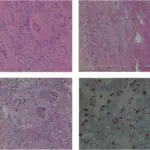Periventricular mass lesions are a broad collection of pathological processes that result in changes on brain imaging. Periventricular mass lesions include a very disparate group of conditions ranging from infection (abscess) to brain tumors.
What is the Pathology of Periventricular Mass Lesions?
Etiology: The causes of periventricular mass lesions depends on the underlying cause which may include age related changes, infections, trauma, and tumors.
Pathogenesis: Age is certainly the most common association of periventricular mass lesions.
Histology: The histology associated with periventricular mass lesions shows microcysts filled with basophilic myxoid substance, clustering of nuclei, and finely fibrillary background. There is loose matrix and clusters of cells embedded in it.
How does Periventricular Mass Lesions Present?
Patients with periventricular mass lesions are typically males, and common above 50 years of age. The symptoms, features, and clinical findings associated with periventricular mass lesions include nausea, vomiting, headaches, visual disturbances, and loss of concentration.
How are Periventricular Mass Lesions Diagnosed?
Periventricular mass lesions are diagnosed by imaging.
How is Periventricular Mass Lesion Treated?
Periventricular mass lesion is treated by based on the underlying cause.
What is the Prognosis of Periventricular Mass Lesion?
The prognosis of periventricular mass lesions ranges from good to poor depending on what the underlying cause is.



